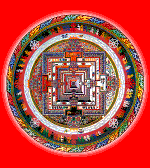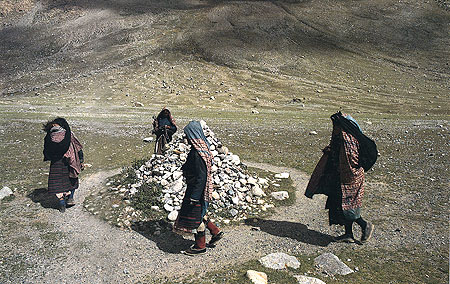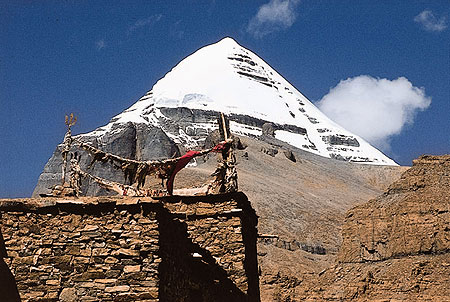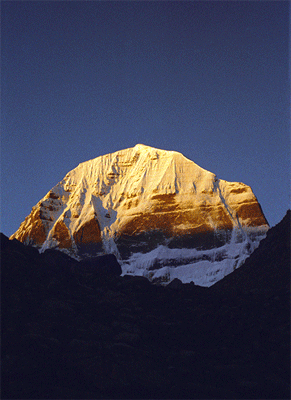| The journey began long before daybreak. We dressed by candlelight and stepped out into the immense silence of the night. The trail began at the Tarchen chorten, marked by a narrow border of white stones. After a half-mile the line dwindled and vanished, and I strained to untangle the path from the shadows. Above gleamed more stars than I had ever seen, extravagant handfuls spangling the midnight fabric of sky. Each time I raised my eyes, another light was arcing across the velvety blackness: the heart-stopping slow slide of a shooting star, so many it seemed the heavens were raining fire. On earth too a light moved; the lamp of a lone pilgrim, an old Tarchen woman bound, she told us, on the sixtieth kora of her life. For a long while I walked beside her, listening to the low hum of her mantra, | ||
|
||
| We
walked without pause for three hours before dawn began its silent
approach. Gradually, slowly, the sky lightened; the clouds streaked
blue and violet, then brightened in the north ahead into ribbons of
rose and gold. The shapes of mountains became distinct, awakened
from their nightlong vigil. A fresh light breeze lifted the air and
I stopped to catch the quickening changes. New light reflected off
pools on the valley floor, mirroring clouds and mountain. The grey
landscape shaded into delicate pastels, then, so imperceptibly that
the exact moment of change could never be pinned to 'now', the full
spectrum of colour blossomed from earth, and it was day. We were ten
miles into the heart of the Kailas kora. Kailas' thirty-two-mile pilgrim path begins at Tarchen, where a range of buttressing hills hides the mountain from view. The route runs westwards through a land of dry scrub and golden dust. To the left unfurls the Barkha Plain, a smooth flat canvas of earth dappled by shifting cloud shadows. Far in the distance the land crests into waves of mountain ranges which continue for nearly eighty miles, until the jagged peaks of the Himalaya rise in an abrupt barrier. The path skirts the northernmost edge of this vast expanse. Countless heaps of stone piled up by pilgrims mark both sides of the trail, offerings that clear the way for those who follow. The cairns multiply as the path climbs a slight rise and swings to the north. Here Kailas makes its appearance, and all bow before the sight at the first of the path's four chaktsel gang, prostration stations that anchor the pilgrim route with prayer. The mountain's white cone glitters like a great ice-diamond in the sky. The intense light and clear air give it a brilliance rivalling the mythical Mount Meru, 'the Mountain of Blazing Appearance' as the Aryans called it. The sight recalls the splendid description of Meru in the Mahabharata: 'Kissing the heavens by its height, shining like the morning sun and like a fire without smoke, unmeasurable and unapproachable by men of manifold sins.' As I drew slowly nearer up the narrow valley, the feeling of penetrating a sanctuary was intensified by the utter silence. Months in Tibet taught me the immensity of true silence. It is not tranquil and soothing as we like to imagine it - that is merely quiet, its vastness reduced by a comforting murmur of sound, birdsong or wind-rustled leaves. In the sweeping emptiness of Tibet these familiar props are stripped away, and one is confronted with a stark and total absence of sound, dizzying in its purity. The ears ring, straining for reassurance, but there is nothing, a void, and the feeling heightens with each step that one is entering into an unknown realm. The silence deepened, and then the birds came — also, oddly, silent; only the sound of wings cutting through the air. For the first time I heard the differences of flight: the heavy slice of a raven's wing, the hawk's single controlled ruffle of wing tips, the whir of a flock of tiny finches rising as one from the brush. Their fluttering wings reflected light like bits of silver paper tossed into the air, like the small printed paper squares Tibetans toss at the top of mountain passes, offering their prayers to the wind. On certain days the leaden flap of vultures' wings breaks the hush. The sight of one wheeling overhead draws two, then more, until an entire flock circles lazily above. They alight atop a flat-topped cliff rising at the head of the golden meadow. Here in the shadow of Kailas, the sky burial ceremony is performed when a death occurs among local people. Bodies are ritually dismembered and fed to the birds in a last act of compassion, a final offering to living beings. Below the cliffs rises the thirty-foot flagpole of Tarboche, a brilliant fluttering mass set against black-shadowed canyon walls. Pilgrims parade about it in single file, a wheel of ritual beneath the mountain, while prostrators stretch out on the path around it, inching about more slowly. Nearby the sun-moon pinnacle of Chorten Kangnyi glows in the slanting light. The monument's ochre-stained body and slender spire counterbalance the snowy bulk of Kailas rising above. Colour and form speak more clearly than words of the presence of a holy place to which this chorten is the gateway. The real journey begins here, as the pilgrim passes beneath the 'Two-legged Chorten' to receive its blessings and enters the Lha Chu Valley, the Valley of the River of the Gods. The air is charged with a growing expectancy; one senses immediately this is a realm where everything is somehow more than it appears. The rock cliffs carved with mantra inscrip¬tions, the streams that water the lush meadow and the wildflowers starring its long grass — these are rock, water, blossom and something more; in the heightened reality the pilgrim moves in, they are manifestations of the Infinite, and those who sense this unwittingly follow the instructions of the Demchog Tantra, the text of Kailas' highest divinity: One should regard oneself and all that is visible as a divine mandala . . . every audible sound is to be regarded as mantra and every thought arising in one's mind as a magic manifestation of the Great Wisdom. To see every thing as sacred, to recognize whatever occurs as a step on the spiritual path; this is the goal of Tantra, and it comes of its own accord here, a place where nature has set divinity in tangible form. From the valley floor I looked up in wonder at the cliffs that lined both sides, their towering walls of soft reddish sandstone sculpted by wind and water into a gallery of fantastic forms. Battlements, parapets, terraces and towers were piled atop one another in an extravagant fantasy, 1500 vertical feet of Nature's wildest hallucinations frozen into solid stone. Atop the ridgeline the silhouetted ruins of abandoned cities appeared, only to vanish within the space of a few steps, an illusion of this strangely architectural rock. The scene had all the grandeur and intricacy of a gigantic palace, constructed on a scale far beyond human conception. The colour of the rock alone was a sufficient marvel, subtle striations of orange and rose shot with mineral veins of greenish-blue. High up, silvery ribbons of waterfalls laced the sheer rock face. In autumn they would freeze into a solid torrent of icicles, and snow crystals would dust the fretted edges of the rock cliffs, etching strange hieroglyphs. The total effect was of having entered another realm, and the travellers encountered on the path only increased the feeling of timelessness. Out of nowhere a horseman on a white pony appeared, a long dagger thrust through his sash. 'Tashi delek!' he shouted in greeting, and trotted off, the jingle of the harness trailing behind. From across the Lha Chu came the sound of whistles and shouts, as a nomad family urged forward a flock of pack-sheep loaded with salt for trade in the high remote valleys to the north. A pair of monks from distant Amdo passed by, maroon robes swaying from side to side like the swinging of a bell. Far ahead, the tiny figures paused to adjust their loads and tramped off again into the vastness of the canyon. All pilgrims had the same destination, |
||
|
||
| in an oracular tradition passed down from father to son.
Today the oracle is silent, but Kangri Lhatsen is honoured in a
special small shrine of Chukku set off from the main temple. Like
all such gonkhang devoted to fierce deities, its doors are shut to
women; laymen enter only on special occasions. The path to the gompa twisted uphill through a maze of multi-coloured boulders carved with mantra. At the very top waited a woman; silver coins braided into her hair identified her as a Golok, one of the nomadic tribespeople of northeast Tibet. Three children dressed in miniature chuba peered solemn-eyed from behind her skirts. We sat together on the temple steps and she talked of her long journey. It had taken her nearly a year to reach Kailas, and she listed the pilgrimage sites visited along the way: Lhasa, Tsari, Samye, Sakya . . . The litany of sacred place-names evoked a vision of an invisible net of pilgrim paths flung over Tibet, distant places linked in an unseen web of power. As we talked the children lost their shyness and began to play, pitching pebbles over the edge of the terrace and giggling as they ricocheted down the steep slope. Eventually a monk emerged from his quarters to unlock the door of the main temple, the lhakhang or 'god-house'. Inside, the dim air was heavy with the scent of incense and melted butter. Pools of light spilled over the edges of silver butter lamps into the darkness. The walls were lined with silver chorten and gilded images — all that remained of the treasures of Kailas' six monasteries, gathered together here when Chukku became the first gompa to be rebuilt after the Cultural Revolution. Niches on the back wall held the 108 brocade-wrapped volumes of the Kanjur, the records of the Buddha's speech. As the woman circled the temple the children imitated her actions, bowing their heads against the holy scriptures. At the centre of the room on the main altar a single image sat amid ivory tusks and peacock feathers, its features nearly buried by a blizzard of prayer scarves. The squat white figure was utterly unlike the serene gilded Buddhas usually found in Tibetan shrines; with its topknot and almond eyes, it faintly resembled the Tirthankara images of Jain desert temples. Its blank-eyed stare was oddly disturbing; it seemed alien, out of place among the ritual Tibetan paraphernalia surrounding it. The Golok woman prostrated three times before the statue, then stood a long moment hesitating. Slipping off her bright necklace of polished stones she handed it to the monk, who draped it over the image in offering. This statue is called Chukku Rinpoche after the Gompa's sixteenth-century founder, but its legend goes back even further, into the timeless realm of myth. From the cloudy waters of a Milk Lake in India's Lahoul region seven white images were magically self-born. One of these made its way to Kailas, where it was enthroned as the central treasure of Chukku Gompa. 'Outside, what is important is Kang Tise [Kailas]', an old saying has it. 'Inside, Chukku Rinpoche is the most important.' The presence of this strange statue seems to inspire a climate ready for miracles. In addition to it, the gompa possesses a silver-inlaid conch shell magically flown from Lake Manasarovar and an immense copper vessel said to have been brought from India by the Buddhist missionary Tilopa. These three objects represent the Buddha's Body, Speech and Mind; their union is a sign that religion will flourish in Tibet. The Cultural Revolution scattered the treasures of Chukku; later the image and the conch were returned, but the copper bowl had disappeared — stolen, perhaps, or melted down for scrap metal like so many other precious artifacts. Then, in 1985, on the day of a religious festival, the vessel of the Buddha's Mind appeared in a cave beneath the gompa. 'We looked there many times before without finding it', the monk told us. 'It was Kangri Lhatsen who reunited the three treasures', he added with conviction. And like the thick ice cap crowning Kailas and the deep waters flowing in the Ganga Chu, this is taken as an auspicious omen that the Buddhist Dharma, the Way, will again flourish in Tibet. Watching the pilgrims' spellbound faces as the monk told his magic tale, I marvelled again at how easily Tibetans seem to slide between different realms of reality. A tale of the incredible is related in the same matter-of-fact tone as a comment on the weather, and is accepted with the same trust. To challenge such statements is out of place in Tibet, where philosophy and faith combine to blur the boundaries of the possible. This is a land where the supernatural naturally resides, and the veil separating ordinary reality from other realms draws even thinner at Kailas. As the trail moves northwards up the Valley of the Gods, the miraculous and the natural continually meet and merge, until the distinction between legend and fact, belief and truth, wavers and finally melts away altogether. A natural hollow scooped into the rock becomes 'Milarepa's Food Bowl'. On the opposite bank, the wind-whipped waterfall plunging 800 feet straight down in a twisting spiral is the tail of the legendary horse of the legendary King Gesar of Ling. Guru Rinpoche's gigantic torma-cake offering to the deities of Kailas is frozen in the form of a massive rock dome; nearby, Hanuman the Monkey King, a Hindu creation, kneels atop the ridgeline in homage before Shiva's throne. The surrounding mountains themselves are temples, gigantic natural shrines with a grandeur that readily evokes unseen presences to inhabit them. The Three Long-Life Gods, the Sixteen Sattvir, the Seventy-Two Palgun — legions of supernatural beings dwell in the cliffs and summits, invisible but sensed by pilgrims who pray to each. Old prayers to Kailas run on with pages of listed deities: . . . On the right, at the palace like a victory banner I pray to the deities of Chenrezig. Behind, at the palace like a white silk hanging I pray to the one thousand Buddhas of the good Kalpa. On the left, at the crystal palace of small snow I pray to the deities of the Medicine Buddhas. In front, in the palace like a mount of jewels, I pray to the deities of the five hundred Arhats . . . This traditional prayer is still recited today, not just to increase the pilgrim's store of religious merit, but for the benefit and liberation of all sentient beings: With an unchanging mind I have faith I prostrate in homage and do circumambulation . . . Bless us so that we have the power to do limitless good to beings Bless us so that we are bound to act for the supreme liberation of beings Bless us so that we accomplish both our own and others good. In this rich forest of symbols, the narrow categories of legend and fact, belief and reality cannot encompass the whole. The immense pantheon of Tibetan Buddhism springs from the philosophic concept of Emptiness, tongpanyi, said to be the ultimate reality. When all appearances are empty of inherent being, how can one draw lines between illusions? The deities dwelling in their mountain temples and the blue-skinned, twelve-armed Demchog enthroned atop Kailas are at once as real as the solid rock of the mountain's summit, and as illusory as the 'self that perceives all of this. What makes it real is the perception, the belief, and this pilgrims have in full measure. Upon a strangely shaped boulder they sit in the 'Saddle of Faith' to pray for a high rebirth in their next incarnation. They bow before a natural image of the fierce protector Tamdin etched on a black boulder, and move on to circle the footprint of a Buddha embedded in a stone slab. The route is lined with reminders of a spiritual reality, signs left by gods and Buddhas and holy men of such power that the rocks they stood upon still bear the imprint of their feet. Each time I made a circuit I discovered more of these places, head and hand and footprints being circled or bowed to or rubbed with butter. There are so many it seems impossible for a single pilgrim, however devout, to tend to them all in a day; and on a one-day journey the multitude blurs into a single overwhelming impression of sanctity and power. Four Nepali women, Buddhists from a remote northern border region a week's walk south of Kailas, were circling the heap of stones that marked the second prostration station. They paraded about three times then began their bows, rising and falling in ragged unison like waves breaking on a shore. Hands rose, folded, to touch forehead, mouth and heart in quick succession; the women knelt and stretched out full-length face down on the ground until the eight points — knees, stomach, chest, mouth, forehead and hands — touched the earth, and they rose and repeated the process. It was a complete offering of the self, uniting body with earth in total submission before Kailas, which rose up here from encircling bands of ice and rock like Saturn surrounded by its rings. A little further down the trail the north face appeared in profile. To glimpse two of the mountain's four sides at once gave the impression of a faceted jewel, the 'rock-crystal chorten of Bon legend. Here the kora path turned eastwards in its great circle, following the curve of the Lha Chu. In abrupt contrast to the sandstone fantasy left behind, the northern valley was granite, all rounded forms of grey. |
||
|
||
|
At the heart of this great spiritual diagram rises Kailas, its
appearance constantly changing, its presence pervading the entire
region. Of the mountain's infinite variety of forms the most
splendid is the north face, a sheer-walled monolith rising 5000 feet
straight up like a gigantic temple hewn from rock and ice by
supernatural hands. 'The grandeur and sublimity of the view and the
spiritual atmosphere pervading there is simply indescribable', Swami
Pranavananda wrote in his guidebook. Two smaller sentinel hills
flank the tremendous pyramid, their balanced forms complementing its
symmetry. Directly across from this vision stands Dirapuk Gompa, built in a setting to awe the spirit. On this spot Tantrik initiates meditate on Demchog's Mandala of Supreme Bliss, hoping to gain a vision of their devotional deity, be it Shiva or Buddha or any of the legions of presences who inhabit the region. Ordinary pilgrims know little of such mystic practices, but they too are awed by the mountain's holy presence and repeat their mantras all the more fervently. In a dirt-floored room of the monastery they share a simple meal and sleep under their sheepskin chuba, while outside Kailas glows in unearthly beauty in the cold moonlight. One evening I sat alone atop the flat roof of Dirapuk, watching dusk's slow slide into night. Darkness pooled in the valley's crevices and spread in an inky wave to lap against the circles of light cast by nomads' campfires. More fires were kindled; they seemed to call forth answering lights from the sky as stars pinpointed the darkness overhead. Atop the monas¬tery I felt suspended between earth and sky; warm flames below, cold fire above. Between the two realms Kailas rose in icy silence, power etched upon its broad rock face in an inscrutable statement. For a few minutes I tried to reduce somehow that tremendous vision into words. Then I laid my notebook down. The mountain possessed a self-contained reality that rendered it impervious to all attempts to describe or explain. It was as impenetr¬able as the adamantine vajra which to Buddhists symbolizes the Absolute. The mountain was perfect, perfect beyond the right of any natural thing to be, and the deliberateness implied in its form pointed to a higher reality — a realm which man in his imperfection cannot directly approach, and so must resort to symbolism to speak of the unspeakable. It is perfect, but we are not, and so it is a statement only dimly comprehended by our present minds, a power sensed yet unarticulated, inaccessible to reason. Words can never contain the immensity of such an experience; they only reduce its integrity. In the icy moonlight the mountain glowed with a beauty beyond human reassurance, something deep and cold. |
||
| Text by Kerry Moran |



